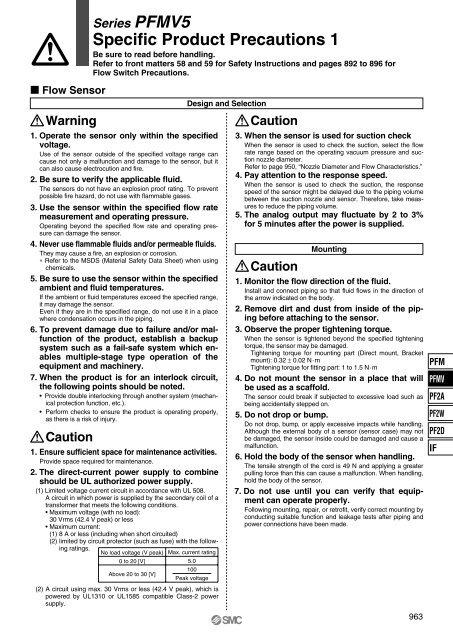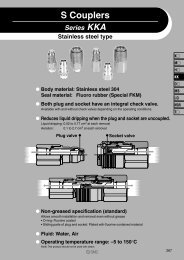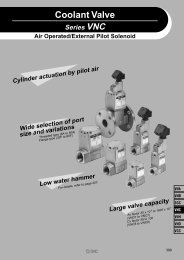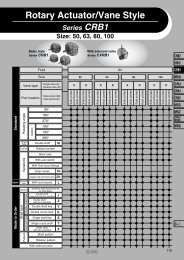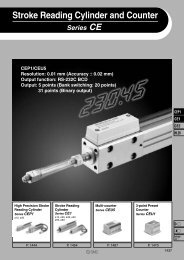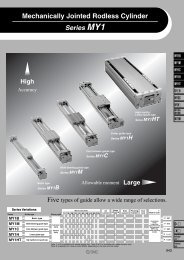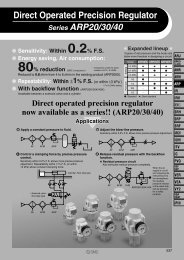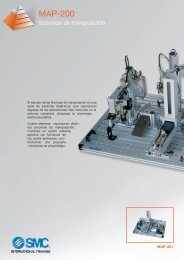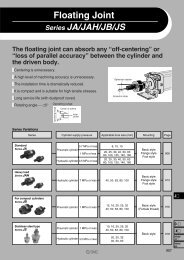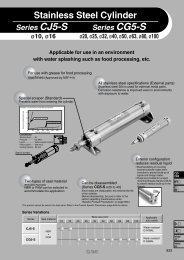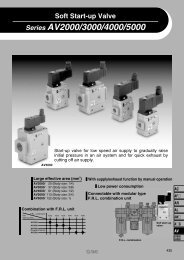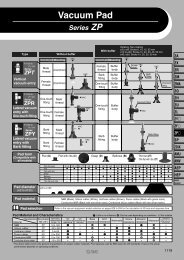Series <strong>PFMV</strong>3Function Details Output operationThe output operation can be selected from the following:Output (hysteresis mode and window comparator mode) correspondingto receiving voltageAt the time of shipment from the factory, it is set to hysteresis mode and reverse output. Displayed valuesThe monitor receives the output voltage of the connected sensorand displays the received voltage. The unit is [V] and the voltageis displayed at 0.01 V intervals.However, the voltage under 0.70 V is displayed as “LLL” and thatof 5.1 V or more is displayed as “HHH”.Since the voltage is displayed on the monitor, it doesn’t rely onthe sensor range. Indication colorThe indication color can be selected foreach output condition. The selection ofthe indication color provides visual identificationof abnormal values. (The indicationcolor depends on OUT1 setting.)Green for ON, Red for OFFRed for ON, Green for OFFRed all the timeGreen all the time Setting of response timeThe flow rate may change momentarily during2 mstransition between ON (open) and OFF (closed) of10 msthe valve. It can be set so that this momentarychange is not detected.50 ms0.5 s1 s Auto-shift functionIf the supply pressure of the air source fluctuates, the flow rate ofvacuum generators such as an ejector also fluctuates. In thatcase, the switch may not operate properly when checking absorption.Auto-shift is a function that corrects this fluctuation.This function sends the output corresponding to the relativechange based on the flow rate when the auto shift signal is input.Set value = 0.50: The switch turns ON and OFF when the setvalue increases by 0.5 V from the reference value.Set value = –0.50: The switch turns ON and OFF when the setvalue decreases by 0.5 V from the reference value.The reference value shows the voltage (= flow rate) when theauto-shift signal is input.Flow rate QFlow rate QTurns ON below the set value.Supply pressure fluctuationSet valueONOFFAuto-shift inputONStay ON(doesn’t turn ON or OFF)Supply pressure fluctuationONTimeSet value - 0.5 (turns ON when the set value decreases by 0.5.)Turns ON when the setvalue decreases by 0.5.Operateproperly. Auto-preset functionThis is a function that calculates the set value automatically.When predetermined operation is conducted while the sensor isconnected, the set value is calculated and decided automaticallyby changing the flow rate. (Fine adjustment is available.) Selection of power-saving modeThe power-saving mode can be selected.With this function, if no buttons are pressed for 30 sec., it shifts topower-saving mode.At the time of shipment from the factory, the product is set to thenormal mode (the power-saving mode is turned off).(When power-saving mode is activated, the decimal point flashes.) Setting of secret codeThe user can select whether a secret code must be entered to releasekey lock.At the time of shipment from the factory, it is set such that the secretcode is not required. Peak/Bottom value indicationThe maximum (minimum) voltage is detected and updated fromwhen the power supply is turned on. In peak (bottom) value indicationmode, this maximum (minimum) voltage is displayed. Keylock functionPrevents operation errors such as accidentally changing settingvalues. Error indication functionWhen an error or abnormality arises, the location and contentsare displayed.Description Contents ActionInput voltageerrorSystem errorThe voltage outside theapplicable indicationrange is input.Possibility of internal circuitdamage before factoryadjustment.System error. Possibilityof data memorizing failureor internal circuitdamage.Check the input voltage.Stop operation immediatelyand contact<strong>SMC</strong>.Reset the unit, and carryout all settings again.If the error or abnormality cannot be solved by the action above, please contact <strong>SMC</strong>for further investigation. Reference value correcting functionIf the displayed value doesn’t become 1.00 due to the differenceof the analog output of the connected sensors <strong>PFMV</strong>505, 510and 530, the reference value will compulsively be set to 1.00.When sensors <strong>PFMV</strong>505F, 510F and 530F are connected, thereference value will compulsively be set to 3.00.Press the and buttons simultaneously for 1 second ormore when the flow rate is zero (The display flashes when successfullycorrected).The effective range of the correcting function is from 1.00 ± 0.2 Vor 3.00 ± 0.2 V. If the monitor is operated outside this range, itdisplays “Er4” and the reference value won’t be corrected. Besure to operate the monitor when the flow rate is zero.When the PFM505 is used and the flow rate is applied, pleasepay attention to the following point. If this correcting function isapplied around 3.00 V, the reference value will be changed andthe function won’t work properly. If the monitor is improperly operated,return the flow rate to zero and operate the monitor again.962OFFOFFTime
Flow SensorWarningSeries <strong>PFMV</strong>5Specific Product Precautions 1Be sure to read before handling.Refer to front matters 58 and 59 for Safety Instructions and pages 892 to 896 forFlow Switch Precautions.1. Operate the sensor only within the specifiedvoltage.Use of the sensor outside of the specified voltage range cancause not only a malfunction and damage to the sensor, but itcan also cause electrocution and fire.2. Be sure to verify the applicable fluid.The sensors do not have an explosion proof rating. To preventpossible fire hazard, do not use with flammable gases.3. Use the sensor within the specified flow ratemeasurement and operating pressure.Operating beyond the specified flow rate and operating pressurecan damage the sensor.4. Never use flammable fluids and/or permeable fluids.They may cause a fire, an explosion or corrosion.∗ Refer to the MSDS (Material Safety Data Sheet) when usingchemicals.5. Be sure to use the sensor within the specifiedambient and fluid temperatures.If the ambient or fluid temperatures exceed the specified range,it may damage the sensor.Even if they are in the specified range, do not use it in a placewhere condensation occurs in the piping.6. To prevent damage due to failure and/or malfunctionof the product, establish a backupsystem such as a fail-safe system which enablesmultiple-stage type operation of theequipment and machinery.7. When the product is for an interlock circuit,the following points should be noted.• Provide double interlocking through another system (mechanicalprotection function, etc.).• Perform checks to ensure the product is operating properly,as there is a risk of injury.Caution1. Ensure sufficient space for maintenance activities.Provide space required for maintenance.2. The direct-current power supply to combineshould be UL authorized power supply.(1) Limited voltage current circuit in accordance with UL 508.A circuit in which power is supplied by the secondary coil of atransformer that meets the following conditions.• Maximum voltage (with no load):30 Vrms (42.4 V peak) or less• Maximum current:(1) 8 A or less (including when short circuited)(2) limited by circuit protector (such as fuse) with the followingratings.No load voltage (V peak) Max. current rating0 to 20 [V]5.0100Above 20 to 30 [V]Peak voltage(2) A circuit using max. 30 Vrms or less (42.4 V peak), which ispowered by UL1310 or UL1585 compatible Class-2 powersupply.Design and SelectionCaution3. When the sensor is used for suction checkWhen the sensor is used to check the suction, select the flowrate range based on the operating vacuum pressure and suctionnozzle diameter.Refer to page 950, “Nozzle Diameter and Flow Characteristics.”4. Pay attention to the response speed.When the sensor is used to check the suction, the responsespeed of the sensor might be delayed due to the piping volumebetween the suction nozzle and sensor. Therefore, take measuresto reduce the piping volume.5. The analog output may fluctuate by 2 to 3%for 5 minutes after the power is supplied.CautionMounting1. Monitor the flow direction of the fluid.Install and connect piping so that fluid flows in the direction ofthe arrow indicated on the body.2. Remove dirt and dust from inside of the pipingbefore attaching to the sensor.3. Observe the proper tightening torque.When the sensor is tightened beyond the specified tighteningtorque, the sensor may be damaged.Tightening torque for mounting part (Direct mount, Bracketmount): 0.32 ± 0.02 N·mTightening torque for fitting part: 1 to 1.5 N·m4. Do not mount the sensor in a place that willbe used as a scaffold.The sensor could break if subjected to excessive load such asbeing accidentally stepped on.5. Do not drop or bump.Do not drop, bump, or apply excessive impacts while handling.Although the external body of a sensor (sensor case) may notbe damaged, the sensor inside could be damaged and cause amalfunction.6. Hold the body of the sensor when handling.The tensile strength of the cord is 49 N and applying a greaterpulling force than this can cause a malfunction. When handling,hold the body of the sensor.7. Do not use until you can verify that equipmentcan operate properly.Following mounting, repair, or retrofit, verify correct mounting byconducting suitable function and leakage tests after piping andpower connections have been made.963PFM<strong>PFMV</strong>PF2APF2WPF2DIF


